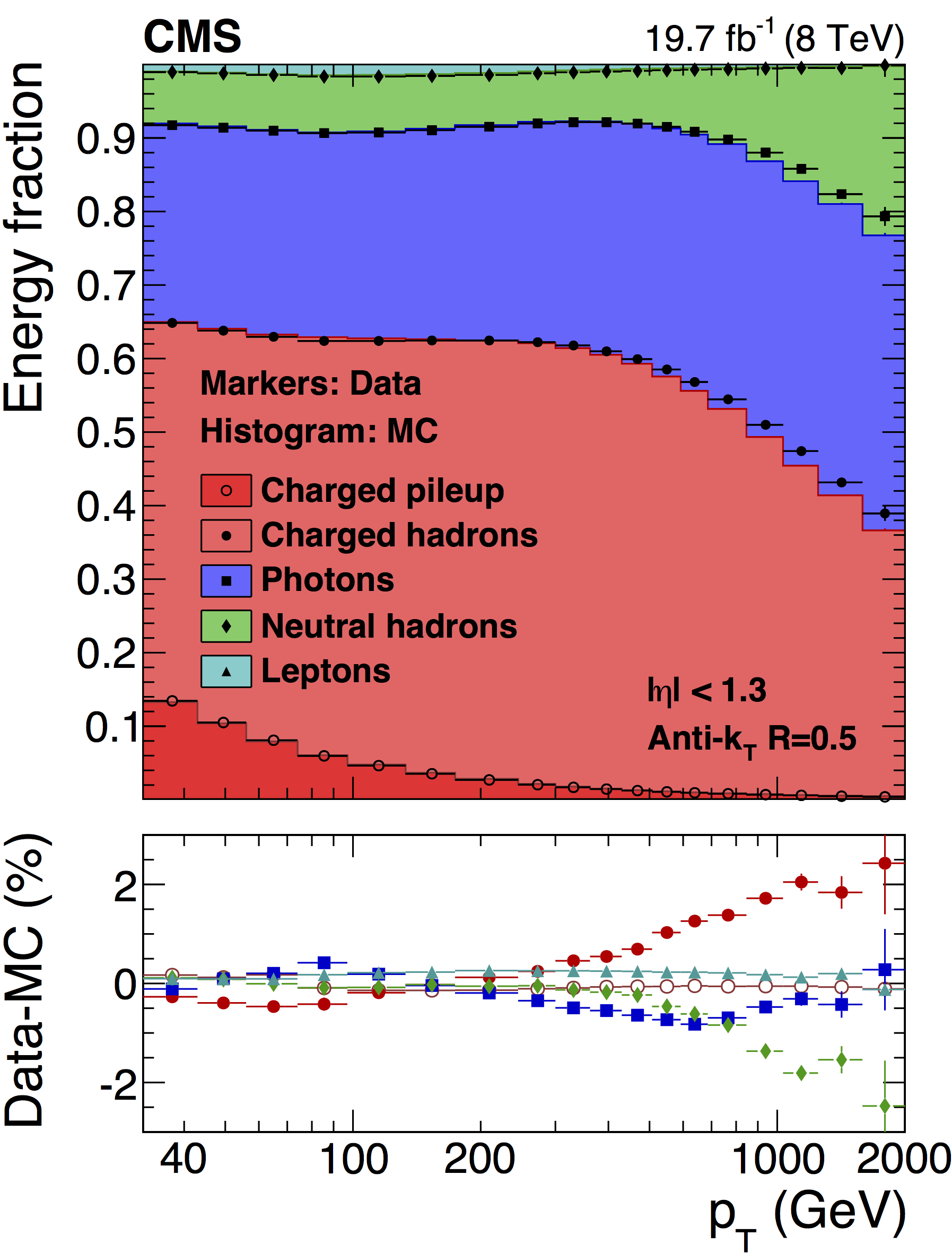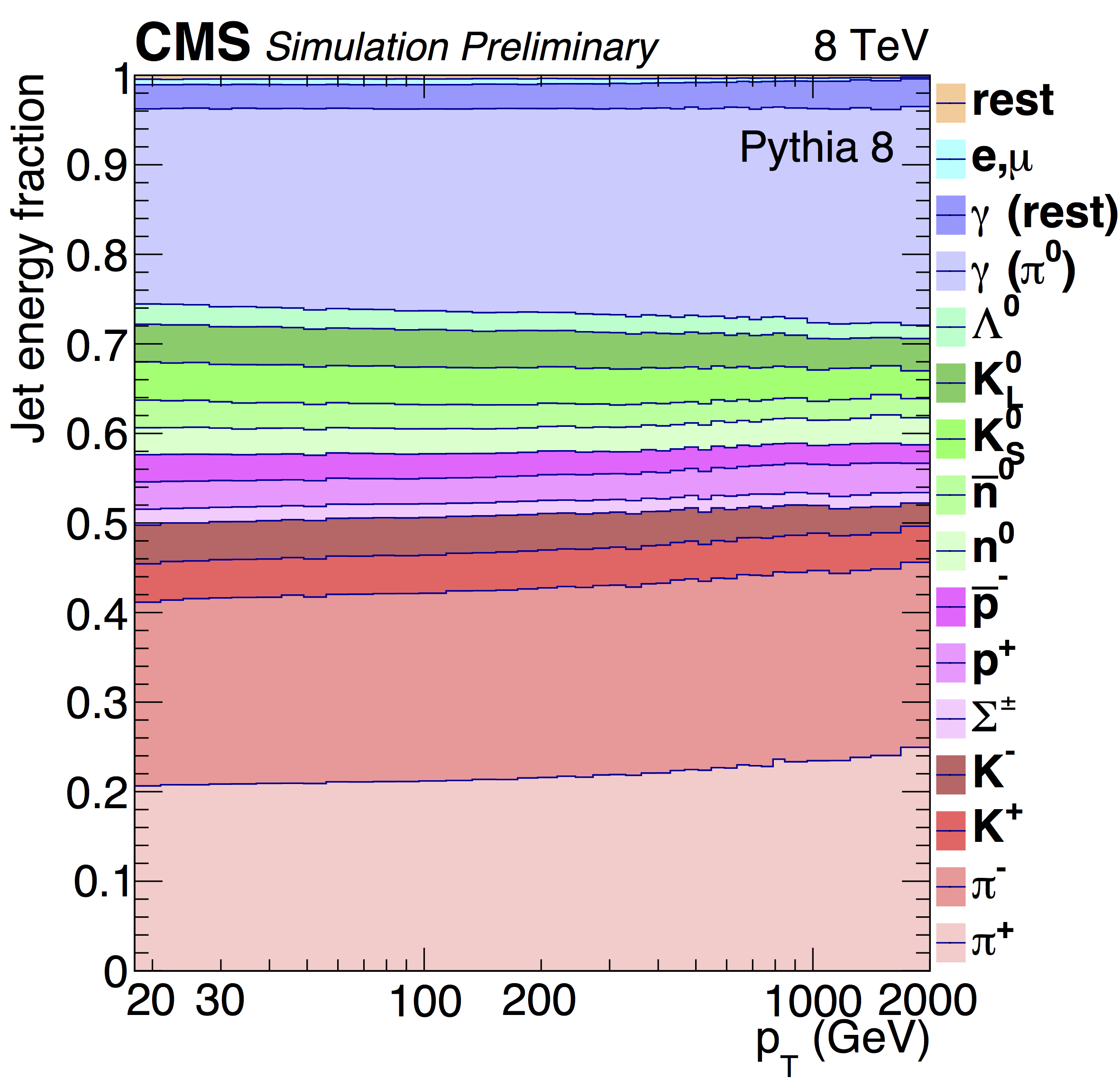Pileup Reweighting and Pileup Mitigation
Overview
Teaching: 40 min
Exercises: 20 minQuestions
What is pileup and how does it afffect to jets?
What is the basic jet quality criteria?
Objectives
Learn about the pileup mitigation techniques used at CMS.
Learn about about the basic jet quality criteria.
After following the instructions in the setup (if you have not done it yet) :
If you are in the your jupyter notebook area of the Purdue AF. On the left, in the
File Browser, go to the folderjets-hats > notebooks. For this part of the tutorial you can open the notebook:Pileup.ipynb.
What is pileup?

The additional interactions that occur in each bunch crossing because the instantaneous bunch-by-bunch luminosity is very high. Here additional implies that there is a hard-scatter interaction that has caused the event to fire the trigger. The total inelastic cross section is approximately 80mb, so if the luminosity per crossing is of the order 80mb-1 you will get one interaction per crossing, on average.
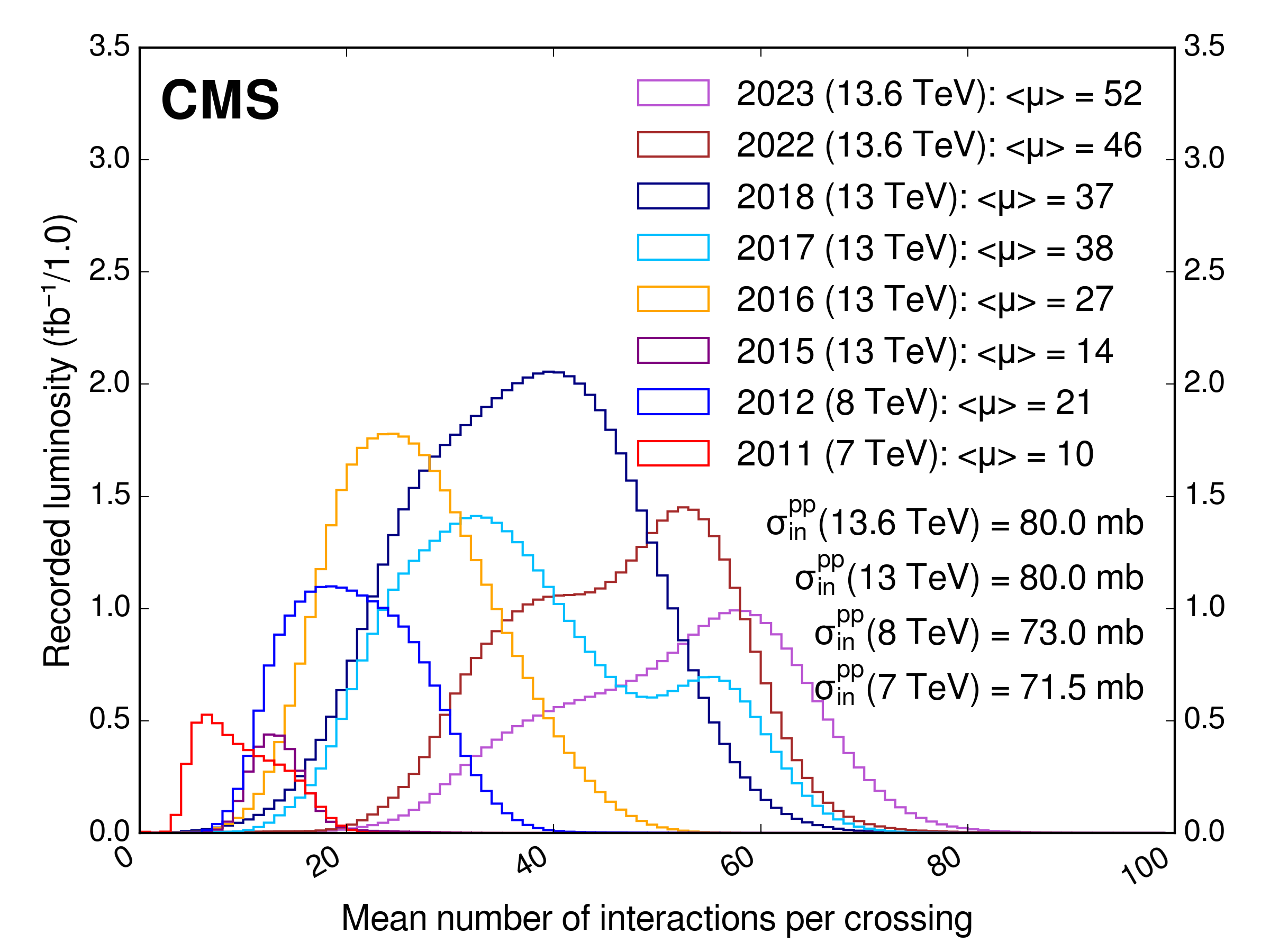
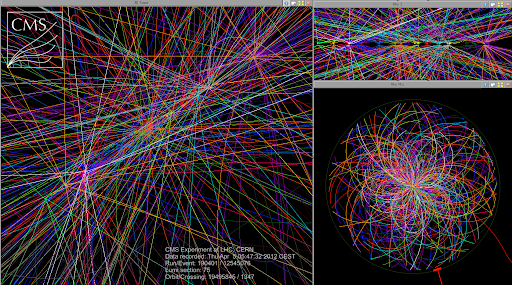
Types of pileup
We can define two types of pileup:
- In-time pileup: the interactions which occur in the bunch crossing that fired the trigger
- Out-of-time pileup: the interactions which occur in the bunch crossings which precede or follow the one which fired the trigger
We need to simulate out-of-time interactions, time structure of detector sensitivity and read-out, and bunch train structure. According to the detector elements used for measuring pileup:
- Tracker: only sensitive to in-time pileup
- Calorimeters: sensitive to out-of-time pileup
- Muon chambers: sensitive to out-of-time pileup
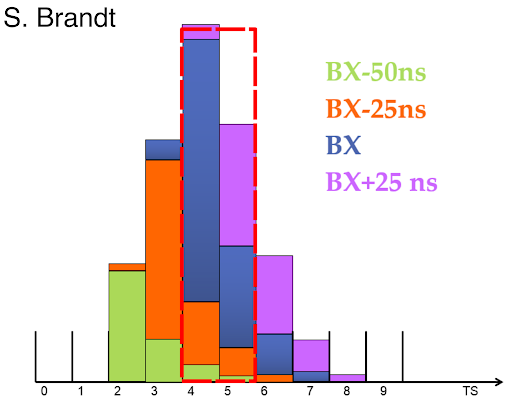
Pileup mitigation algorithms
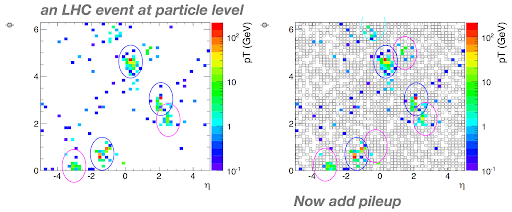
Many clever ways have been devised to remove the effects of pileup from physics analyses and objects. Pileup affects all objects (MET, muons, etc.). We are focusing on jets today.
To mitigate PU in jets, we can do it in two steps, first at particle-level and then at the jet-level.
jet-level PU mitigation: $\rho$ pileup correction
Imagine making a grid out of your detector, then $\rho$ is the median patch value (pT/area). Therefore, the corrected jet momentum is: \(p_T^{corr} = p_T^{raw} - (\rho \times area)\)
This works because pileup is expected to be isotropic. This is a simplistic version of what the L1 JECs do to remove pileup. More about JECs later.

Exercise 2.1
Before we get into mitigating pileup effects, let’s first examine measures of pileup in more detail. We will discuss event-by-event variables that can be used to characterize the pileup and this will give us some hints into thinking about how to deal with it. We can define:
- NPU: the number of pileup interactions that have been added to the event in the current bunch crossing
- mu: the true mean number of the poisson distribution for this event from which the number of interactions each bunch crossing has been sampled
- $\rho$: rho from all PF Candidates, used e.g. for JECs
- NPV: total number of reconstructed primary vertices
Open a notebook
For the first part, open the notebook called
Pileup.ipynband run exercise 2.1.
Question 2.1
Why are there a different amount of pileup interactions than primary vertices?
Solution 2.1
There is a vertex finding efficiency, which in Run I was about 72%. This means that $N_{PV}\simeq0.72{\cdot}N_{PU}$
Question 2.2
Rho is the measure of the density of the pileup in the event. It’s measured in terms of GeV per unit area. Can you think of ways we can use this information the correct for the effects of pileup?
Solution 2.2
From the jet $p_{T}$ simply subtract off the average amount of pileup expected in a jet of that size. Thus $p_{T}^{corr}{\simeq}p_{T}^{reco}-\rho{\cdot}area$
Question 2.3
This plot shows the jet composition. Generally, why do we see the mixture of photons, neutral hadrons and charged hadrons that we see?</font>
Solution 2.3
A majority of the constituents in a jet come from pions. Pions come in neutral ($\pi^{0}$) and charged ($\pi^{\pm}$) varieties. Naively you would expect the composition to be two thirds charged hadrons and one third neutral hadrons. However, we know that $\pi^{0}$ decays to two photons, which leads to a large photon fraction.
particle-level PU mitigation
Unfortunately, pileup is not really isotropic, it is uneven. Pileup particles produce additional tracks and deposits in the calorimeters, which are also reconstructed as PF candidates and can overlap with PF candidates belonging to a jet.
The paticle-level PU mitigation techniques ensure an inherently local correction. The two techniques used in CMS are:
- Charged Hadron Subtraction (CHS) mitigates this charged pileup contribution by removing charged particles originating from pileup vertices. However, it is limited to the tracker-covered region and does not account for neutral pileup contributions.
- PileUp Per Particle Identification (PUPPI) complements CHS by assigning a probability to each particle, quantifying its similarity to pileup. It operates under the assumption that particles originating from the hard scatter process are likely to be near (geometrically) other particles from the same interaction and generally have higher pT. In contrast, particles from pileup tend to lack shower structure, have lower pT, and are uncorrelated with particles from the leading vertex. These estimated probabilities are then used to assign weights to the four-momentum of the particles.
Exercise 2.2
Open a notebook
For this part open the notebook called
Pileup.ipynband run the Exercise 2.2
Discussion 2.2
Do you see any difference in the jet pt for CHS and PUPPI jets? Where you expecting these results?
Pileup reweighting
The Goal of the pileup reweighting procedure is to match the generated pileup distribution to the one found in data:
- Step 1: Create the weights
- Step 2: Apply the event-by-event weights
Exercise 2.3
Here we are going to produce a file containing the weights used for pileup reweighting using
json-pog and correctionlib.
Open a notebook
For this part open the notebook called
Pileup.ipynband run the Exercise 2.3
Question 2.4
Ask yourself what pileup reweighting is doing. How large do you expect the pileup weights to be?
Question 2.5
In what unit will the x-axis be plotted? Another way of asking this is what pileup variable can be measured in both data and MC and is fairly robust?
Solution 2.5
The x-axis is plotted as a function of $\mu$ as this is a true measurement of pileup (additional interactions) and not just some variable which is correlated with pileup. Other options might have been $N_{PV}$, which has an efficiency which is less than 100%, and $\rho$, which assumes that the pileup energy density is uniform. We also get different values of $\rho$ if we measure it for different regions in $\eta$ (i.e. $|\eta|<3$ or $|\eta|<5$).
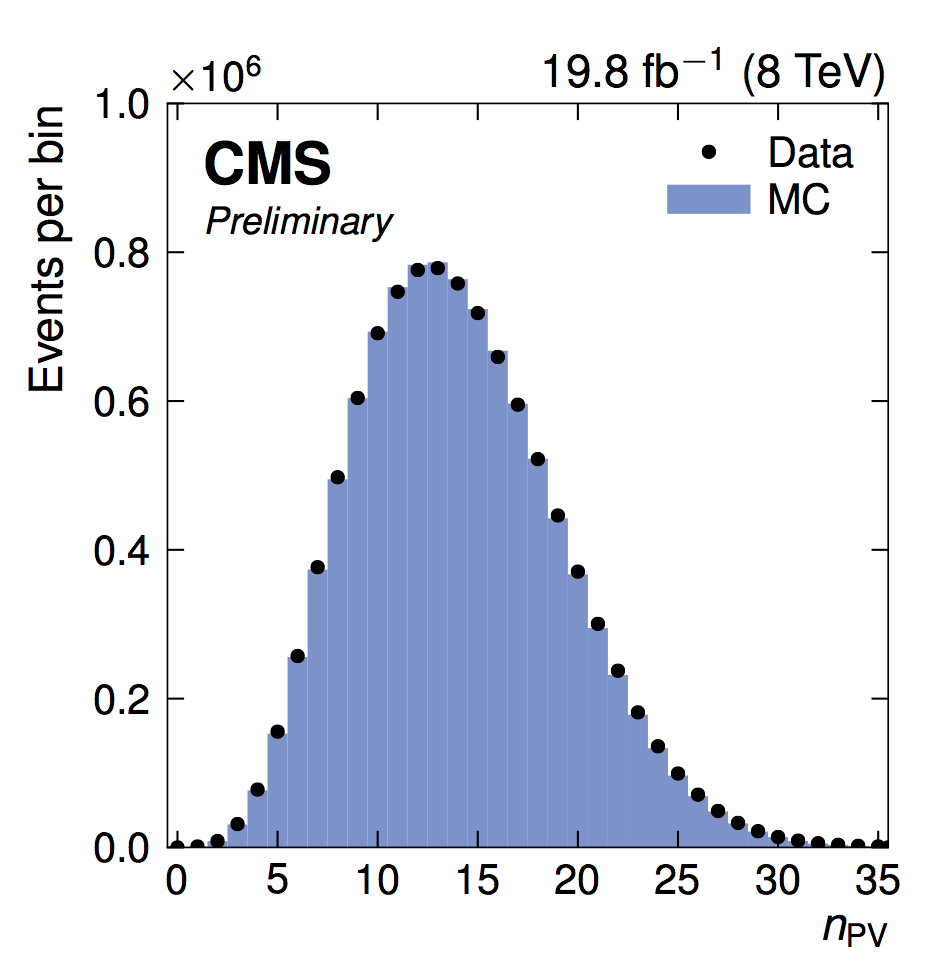
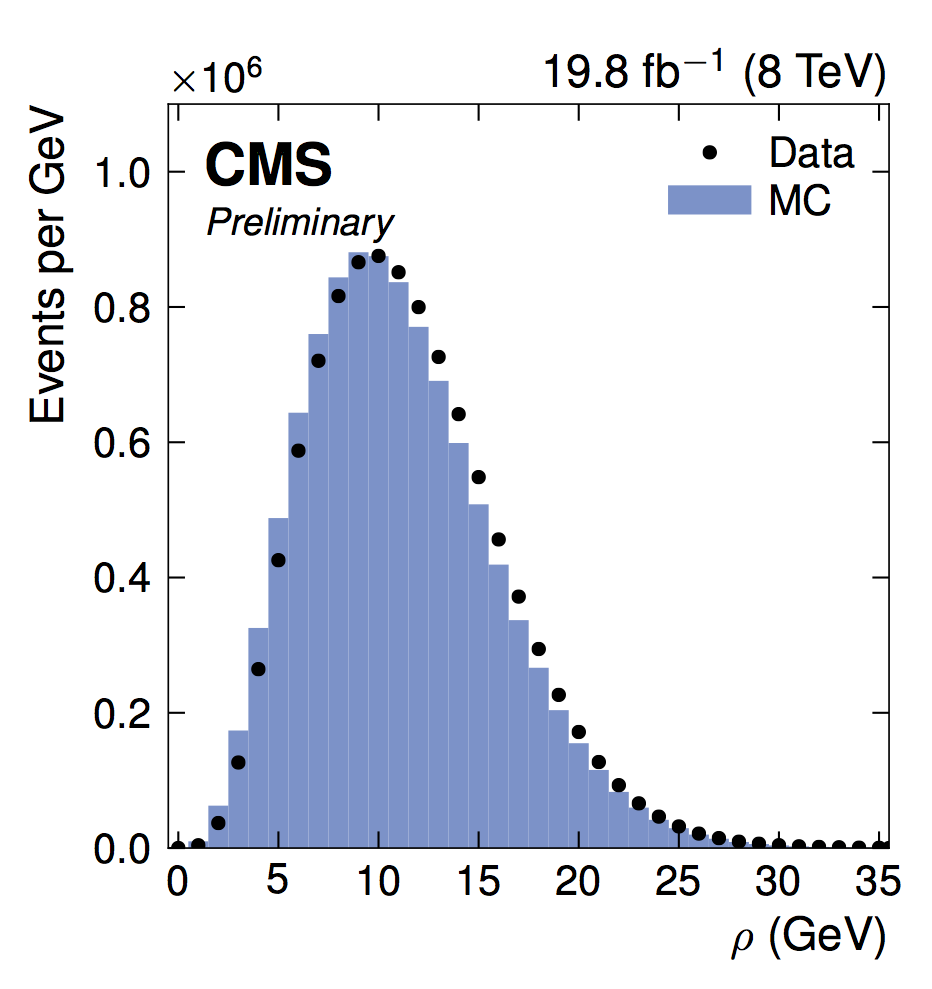
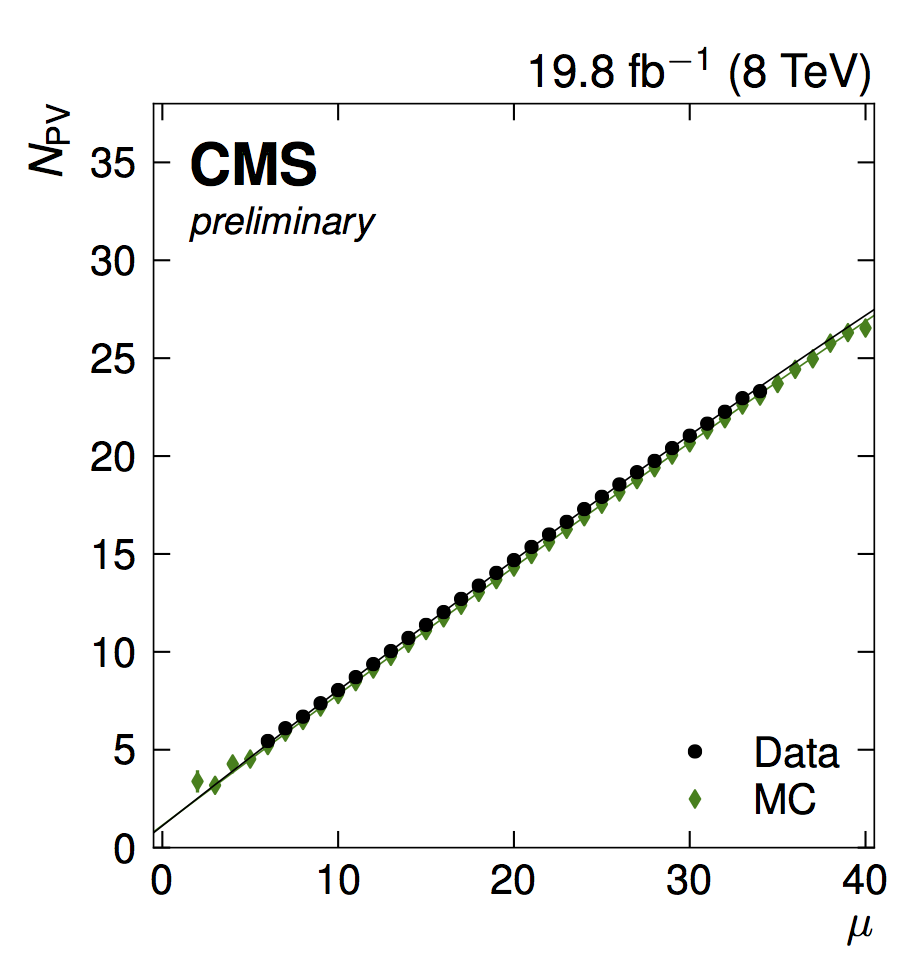
</details>
Question 2.6
Why do the green and red histograms end arount $\mu\approx38$?
More information
To learn more about pileup, you can follow the CMSDAS short exercise about pileup here: (FIXME)
Noise Jet ID
In order to avoid using fake jets, which can originate from a hot calorimeter cell or electronic read-out box, we need to require some basic quality criteria for jets. These criteria are collectively called “jet ID”. Details on the jet ID for PFJets can be found in the following twiki:
https://twiki.cern.ch/twiki/bin/viewauth/CMS/JetID
The JetMET POG recommends a single jet ID for most physics analysess in CMS, which corresponds to what used to be called the tight Jet ID. Some important observations from the above twiki:
- Jet ID is defined for uncorrected jets only. Never apply jet ID on corrected jets. This means that in your analysis you should apply jet ID first, and then apply JECs on those jets that pass jet ID.
- Jet ID is necessary for most analyses.
- It is complementary to “MET filters” (hit level noise rejection)
- Jet ID is fully efficient (>99%) for real, high-$p_{\mathrm{T}}$ jets used in most physics analysis. Its background rejection power is similarly high.
Exercise 2.4
Open a notebook
For this part open the notebook called
Pileup.ipynband run the Exercise 3.
In nanoAOD is trivial to apply jetID. They are stored as Flags, where events.Jet.jetId>=2 corresponds to tightID and events.Jet.jetId>=6 corresponds to tightLepVetoID.
If you want to know how this flags are stored in nanoAOD, the next block shows the implementation in C++ from a miniAOD file:
Implementation in c++
There are several ways to apply jet ID. In our above exercises, we have run the cuts “on-the-fly” in our python FWLite macro (the first option here). Others are listed for your convenience.
The following examples use somewhat out of date numbers. See the above link to the JetID twiki for the current numbers.
To apply the cuts on pat::Jet (like in miniAOD) in python then you can do :
# Apply jet ID to uncorrected jet nhf = jet.neutralHadronEnergy() / uncorrJet.E() nef = jet.neutralEmEnergy() / uncorrJet.E() chf = jet.chargedHadronEnergy() / uncorrJet.E() cef = jet.chargedEmEnergy() / uncorrJet.E() nconstituents = jet.numberOfDaughters() nch = jet.chargedMultiplicity() goodJet = \ nhf < 0.99 and \ nef < 0.99 and \ chf > 0.00 and \ cef < 0.99 and \ nconstituents > 1 and \ nch > 0To apply the cuts on pat::Jet (like in miniAOD) in C++ then you can do:
// Apply jet ID to uncorrected jet double nhf = jet.neutralHadronEnergy() / uncorrJet.E(); double nef = jet.neutralEmEnergy() / uncorrJet.E(); double chf = jet.chargedHadronEnergy() / uncorrJet.E(); double cef = jet.chargedEmEnergy() / uncorrJet.E(); int nconstituents = jet.numberOfDaughters(); int nch = jet.chargedMultiplicity(); bool goodJet = nhf < 0.99 && nef < 0.99 && chf > 0.00 && cef < 0.99 && nconstituents > 1 && nch > 0;To create selected jets in cmsRun:
from PhysicsTools.SelectorUtils.pfJetIDSelector_cfi import pfJetIDSelector process.tightPatJetsPFlow = cms.EDFilter("PFJetIDSelectionFunctorFilter", filterParams = pfJetIDSelector.clone(quality=cms.string("TIGHT")), src = cms.InputTag("slimmedJets") )It is also possible to use the
PFJetIDSelectionFunctorC++ selector (actually, either in C++ or python), but this was primarily developed in the days before PF when applying CaloJet ID was not possible very easily. Nevertheless, the functionality of more complicated selection still exists for PFJets, but is almost never used other than the few lines above. If you would still like to use that C++ class, it is documented as an example here.
Question 2.7
What do the jets with jetId represent? Were you expecting more or less jets with jetId==0?
Noisy event filters
Detector noise, cosmic rays, and beam-halo particles can lead to large anomalous missing energy in the detector and can be an indication of problematic event reconstruction. To ensure good event reconstruction, JME POG requires the use of Noisy event filters, formerly called MET filters. For 2018, you can find the list of recommended filters on the twiki.
Exercise 2.5
Here we are going add the Noise filters from thetwiki.
Open a notebook
For this part open the notebook called
Pileup.ipynband after Excercise 3, apply the filters for 2018 in anANDcombination.
Question 2.4
How many events do you reject with this requirement?
Key Points
We call pileup to the amount of other processes not coming from the main interaction point. We must mitigates its effects to reduce the amount of noise in our events.
Many event variables help us to learn how different pileup was during the data taking period, compared to the pileup that we use in our simulations. The pileup reweighting procedure help us to calibrate the pileup profile in our simulations.
The so-called jetID is the basic jet quality criteria to remove fake jets.
